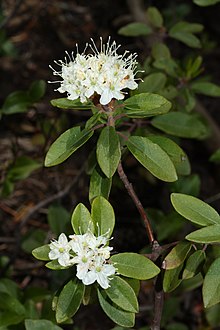Rhododendron columbianum
| Western Labrador tea | |
|---|---|

| |
| Scientific classification | |
| Kingdom: | |
| (unranked): | |
| (unranked): | |
| (unranked): | |
| Order: | |
| Family: | |
| Genus: | |
| Species: | R. columbianum
|
| Binomial name | |
| Rhododendron columbianum (Piper) Harmaja
| |
| Synonyms[1] | |
| |
Rhododendron columbianum, commonly known as western Labrador tea, is a shrub that is widespread in the western United States and in western Canada, reported from British Columbia, Alberta, Washington, Oregon, Idaho, California, Montana, Wyoming, Utah, Nevada, and Colorado. It grows in wet places from sea level up to 3,500 m (11,000 ft).[1] It was formerly known as Ledum columbianum.
Description
Rhododendron columbianum is a shrub up to 2 m (6 ft 7 in) tall, spreading by means of underground rhizomes. The evergreen leaves are ovate to lanceolate, fragrant when crushed. Flowers are white to cream, borne in groups of 10 to 35.[2]
Uses
Rhododendron columbianum has been used medicinally as a tea astringent, diaphoretic, diuretic and laxative properties. The plant can, however, be toxic if the tea is allowed to steep too long. The fragrance of the leaves has also been shown useful in repelling insects and rodents.[3][4]
References
- ^ a b Flora of North America v 8 p 459.
- ^ Harmaja, Harri (1990). Annales Botanici Fennici. 27 (2): 203.
{{cite journal}}: Missing or empty|title=(help) - ^ "Ledum columbianum - Piper". Plants for a Future.
- ^ Plants for a Future, The Goddess Project Archived 2014-02-21 at the Wayback Machine
